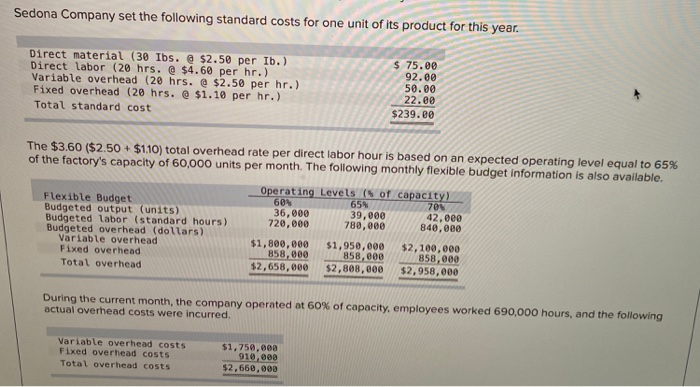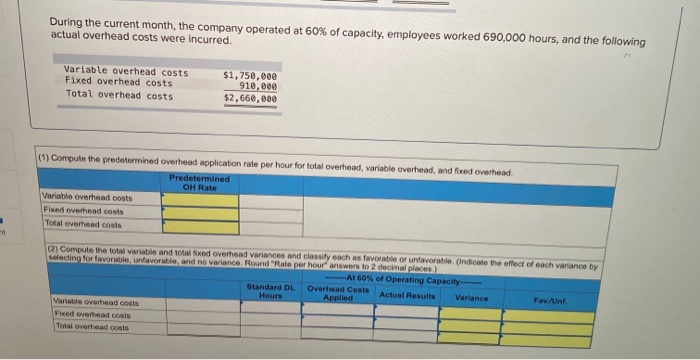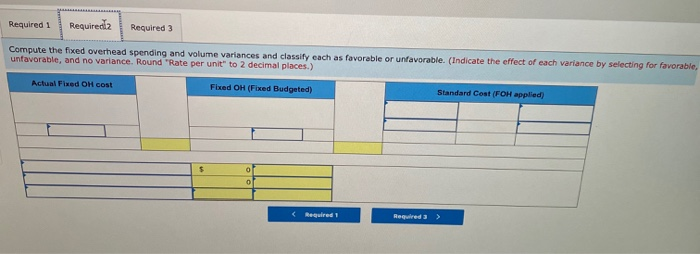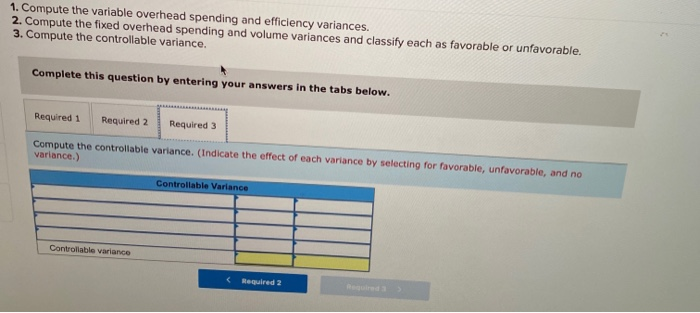Sedona Company set the following standard costs for one unit of its product for this year. Direct material (30 Ibs. $2.50 per Ib.) Direct labor (20 hrs. @ $4.60 per hr.) Variable overhead (20 hrs. @ $2.50 per hr.) Fixed overhead (20 hrs. @ $1.10 per hr.) Total standard cost $ 75.00 92.00 50.00 22.00 $239.00 The $3.60 ($2.50 + $110) total overhead rate per direct labor hour is based on an expected operating level equal to 65% of the factory's capacity of 60,000 units per month. The following monthly flexible budget information is also available. Operating Levels (Sof capacity) Flexible Budget 60% 658 700 Budgeted output (units) 36,000 39,000 42.000 Budgeted labor (standard hours) 720,000 780,000 840,000 Budgeted overhead (dollars) Variable overhead $1,800,000 $1,950,000 $2,100,000 Fixed overhead 858,000 858,000 858,000 Total overhead $2,658,000 $2,800,000 $2,958,000 During the current month, the company operated at 60% of capacity, employees worked 690,000 hours, and the following actual overhead costs were incurred. Variable overhead costs Fixed overhead costs Total overhead costs $1,750,000 910.000 $2,660,000 During the current month, the company operated at 60% of capacity, employees worked 690,000 hours, and the following actual overhead costs were incurred. Variable overhead costs Fixed overhead costs Total overhead costs $1,750,000 910,000 $2,660,000 (1) Compute the predetermined overhead application rate per hour for total overhead, variable overhead, and fixed overhead. Predetermined OH Rate Variable overhead costs Fixed overhead costs Total overhead costs (2) Compute the total variable and total foed overhead variances and classify each as favorable or unfavorable (Indicate the effect of each variance by Selecting for favorable, unfavorable, and no variance. Round "Rate per hour answers to 2 decimal places) At 60% of Operating Capacity- Standard DL Overhead Costs Hours Actual Results Applied Variance Fav/Unl Variable overhead costs Fixed overhead costs Total overhead costs Required 1 Required 2 Required 3 Compute the variable overhead spending and efficiency variances. (Indicate the effect of each variance by selecting for favorable, unfavorable, and no variance. Round "Rate per unit" to 2 decimal places.) Actual Variable OH Cost Flexible Budget Standard Cost (VOH applied) 0 $ 0 ol > Required 1 Requiredia Required 3 Compute the fixed overhead spending and volume variances and classify each as favorable or unfavorable. (Indicate the effect of each variance by selecting for favorable, unfavorable, and no variance. Round "Rate per unit" to 2 decimal places.) Actual Fixed OM cost Fixed OH (Fixed Budgeted) Standard Cost (FOH applied $ 0 0 Required 1 Required 3 > 1. Compute the variable overhead spending and efficiency variances. 2. Compute the fixed overhead spending and volume variances and classify each as favorable or unfavorable. 3. Compute the controllable variance. Complete this question by entering your answers in the tabs below. Required 1 Required 2 Required 3 Compute the controllable variance. (Indicate the effect of each variance by selecting for favorable, unfavorable, and no variance.) Controllable Variance Controllable variance Required 2











